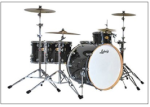Leichter Ladungsträger Goliath Sd.Kfz.302.
GermanKits :: Documentations de matériels en tout genre. :: Documentations de matériels militaires terrestres de toutes nationalités. :: Prototypes, Projets, Déminage, Chars-école, factices et leurres. :: Engins de déminage et de démolition.
Page 1 sur 1
 Leichter Ladungsträger Goliath Sd.Kfz.302.
Leichter Ladungsträger Goliath Sd.Kfz.302.
Leichter Ladungsträger Goliath Sd.Kfz.302.
Specific Features : Measuring about five feet in length, the Goliath was a tracked demolition vehicle powered by two electric motors.
With a screaming top-speed of six miles per hour the Goliath wasn't going to be winning many races against tanks, but it wasn't intended to.
The purpose of the Goliath was to carry a 60kg demolition charge into place and detonate it immediately.
Unlike the Japanese the Germans had almost no vehicles that actively encouraged the pilot to commit suicide.
Even their plane designed to ram into bombers featured the slim safety measure of a detachable cockpit.
To this end the Goliath was essentially a remote controlled bomb on treads
As the Goliath advanced it would spool out a control wire onto the ground, allowing an operator to guide the vehicle from the safety of a trench or bunker.
Later versions of the Goliath utilized a motorcycle engine in place of the electric motors, could carry a heavier demolition charge, and were slightly faster.
The early 1942 versions of the Goliath were prone to small-arms fire, so in the 1943 version the armor was upgraded along with the engine.
While anything bigger than a rifle would make short work of the Goliath it was never intended for use in a running battle.
It was designed with one purpose: to explode!
History : Development of the Goliath began in 1940 after the Germans utilized the much larger, slower, and more cumbersome "Borgward" for minefield clearance.
By reducing the size of the vehicle from 1.5 tons to a little over 700lbs the Germans created a remote-controlled demolition vehicle that could be towed into position and then manhandled without much difficulty by a crew of four or five men.
The unit had a range of only 650 meters and was used almost exclusively for blowing holes in minefields.
By the end of the war over 7,000 Goliaths had been produced and certainly a number of them were used offensively, but this was not their intended purpose.
The Goliaths served most notably in the Kursk Bulge to clear a way for advancing German armor through the deadly minefields.
Some attempts were made at using a TV camera mounted on the Goliath but these proved largely ineffective and the concept was abandoned.

Specific Features : Measuring about five feet in length, the Goliath was a tracked demolition vehicle powered by two electric motors.
With a screaming top-speed of six miles per hour the Goliath wasn't going to be winning many races against tanks, but it wasn't intended to.
The purpose of the Goliath was to carry a 60kg demolition charge into place and detonate it immediately.
Unlike the Japanese the Germans had almost no vehicles that actively encouraged the pilot to commit suicide.
Even their plane designed to ram into bombers featured the slim safety measure of a detachable cockpit.
To this end the Goliath was essentially a remote controlled bomb on treads
As the Goliath advanced it would spool out a control wire onto the ground, allowing an operator to guide the vehicle from the safety of a trench or bunker.
Later versions of the Goliath utilized a motorcycle engine in place of the electric motors, could carry a heavier demolition charge, and were slightly faster.
The early 1942 versions of the Goliath were prone to small-arms fire, so in the 1943 version the armor was upgraded along with the engine.
While anything bigger than a rifle would make short work of the Goliath it was never intended for use in a running battle.
It was designed with one purpose: to explode!
History : Development of the Goliath began in 1940 after the Germans utilized the much larger, slower, and more cumbersome "Borgward" for minefield clearance.
By reducing the size of the vehicle from 1.5 tons to a little over 700lbs the Germans created a remote-controlled demolition vehicle that could be towed into position and then manhandled without much difficulty by a crew of four or five men.
The unit had a range of only 650 meters and was used almost exclusively for blowing holes in minefields.
By the end of the war over 7,000 Goliaths had been produced and certainly a number of them were used offensively, but this was not their intended purpose.
The Goliaths served most notably in the Kursk Bulge to clear a way for advancing German armor through the deadly minefields.
Some attempts were made at using a TV camera mounted on the Goliath but these proved largely ineffective and the concept was abandoned.

_________________
À mon très grand ami Patrice († 58).
À ma petite belle-fille Gaëlle († 31).

Décor "simpliste" sur lequel nous avions rejoué, à 9 joueurs, la Bataille d'Eylau en 1807.

Jacknap1948- Administrateur

- Messages : 16623
Date d'inscription : 28/03/2011
Age : 76
Localisation : 93 + 83 + 22
Humeur : Généralement bonne.
 Sujets similaires
Sujets similaires» Diorama : présentation du Goliath . Steyr 1800 , kettenkrad et goliath -- 1/72
» Sd.Kfz.301 Schwere Ladungsträger Borgward IV (Dessins de Vincent BOURGUIGNON).
» Sd.Kfz.304 Mittlerer Ladungsträger Springer (Dossier Vincent BOURGUIGNON).
» Goliath
» Photoscope SdKfz 302 Goliath
» Sd.Kfz.301 Schwere Ladungsträger Borgward IV (Dessins de Vincent BOURGUIGNON).
» Sd.Kfz.304 Mittlerer Ladungsträger Springer (Dossier Vincent BOURGUIGNON).
» Goliath
» Photoscope SdKfz 302 Goliath
GermanKits :: Documentations de matériels en tout genre. :: Documentations de matériels militaires terrestres de toutes nationalités. :: Prototypes, Projets, Déminage, Chars-école, factices et leurres. :: Engins de déminage et de démolition.
Page 1 sur 1
Permission de ce forum:
Vous ne pouvez pas répondre aux sujets dans ce forum
